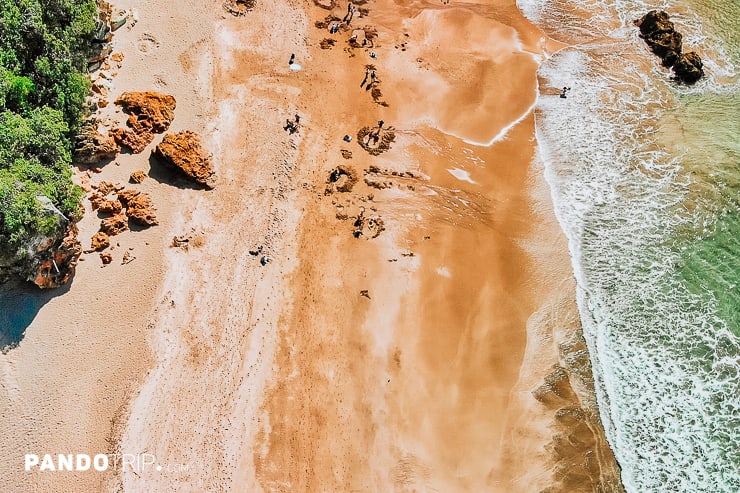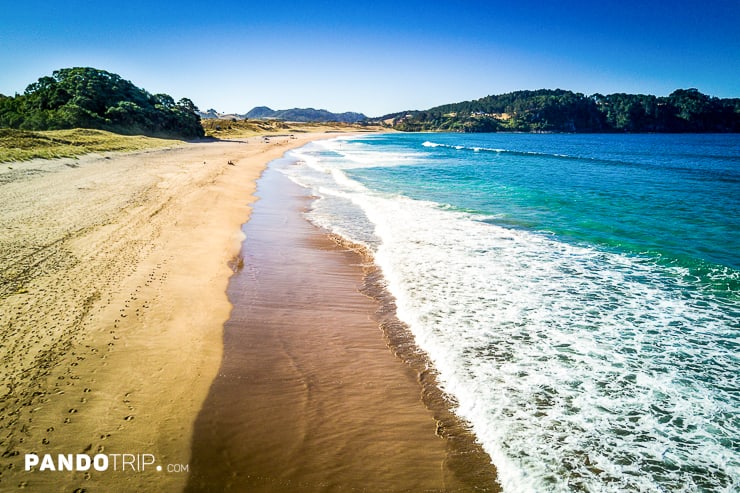Nestled in splendid isolation in the South Pacific, New Zealand remains one of the most pristine and captivating lands on Earth. Comprised of two main islands aptly named the North Island and South Island, this country delights visitors with its magnificent natural landscapes as well as the enduring cultural traditions of the native Māori people. New Zealand’s pure and dramatic beauty inspired its selection as the filming location for multiple Hollywood blockbusters and fantasy epics, bringing this ethereal realm to screens globally.
With countless sights and activities vying for travelers’ attention across both islands, creating an itinerary can prove dauntingly difficult. To aid with trip planning, we’ve highlighted ten quintessential experiences that exemplify the most stunning attractions unique to Aotearoa (the Māori name for New Zealand). Our editors collaborated with seasoned Kiwi travelers and experts to curate this definitive list of the top things every visitor should see or do here, evenly split between the North and South Islands.
While seeing all ten sights proves impractical on one vacation, this guide aims to inspire your own customized itinerary anchored around a few key highlights. Treat these superlative natural phenomena and cultural treasures as must-see events to build upon when devising your own New Zealand dream adventure. Just pick a few favorites and discover what additional nearby gems you can experience in proximity along your personalized route. Whether glowworm caves, volcanic peaks, or hobbit holes capture your imagination most, New Zealand’s beauty beckons across both islands. Let these premier “Ten” set the stage for an unforgettable voyage through this awe-inspiring landscape.
1. Step Into a Starry Wonderland: Waitomo’s Glowworm Caves

Of all New Zealand’s natural wonders, few capture the imagination quite like the glowworm caves. Known as Arachnocampa luminosa, these bioluminescent larvae dot the ceilings of damp limestone caverns, emitting an ethereal blue-green glow to attract prey into the silk snares they weave. This phenomenon remains abundant and easily accessible in New Zealand.
While Australia has similar glowing relatives (Arachnocampa richardsae) visible in places like New South Wales’ Glow Worm Tunnel or Queensland’s Tamborine Mountain Glow Worm Caves, they are not as spectacular as New Zealand’s “glowers.”
The most famous glowworm caves lie in Waitomo on the North Island, featuring underground rivers and limestone formations millions of years in the making. As you float silently down the Waitomo Cave’s sparkling corridor, you’ll swear you’re drifting under a galaxy filled with thousands of blueish-green stars. Waitomo offers several different glowworm cave experiences, from the expansive Glowworm Grotto to more intimate grottos like Spellbound Cave, where the twinkling larvae seem close enough to touch.
Beyond Waitomo, the Kawiti Glowworm Caves of Northland also contain thousands of glowworms illuminating dramatic 200-meter caverns lined with stalactites and stalagmites. On the South Island, visitors can explore the Te Anau Caves. Still expanding from an underground river, these relatively young caves offer a less impressive glowworm display compared to Waitomo’s caves, but the Te Anau Caves remain a good alternative for South Island travelers.
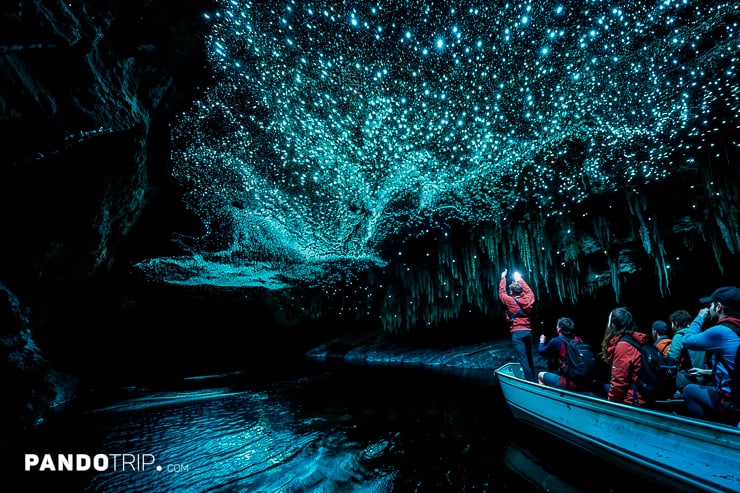


No matter which cave you choose, emerging from the darkness of New Zealand’s glowworm grottoes will leave you spellbound by the natural wizardry unique to this island nation. Of all places worldwide to witness these living lights, New Zealand is the best choice.
2. Hike Through Volcanic Majesty: Tongariro Alpine Crossing

Of New Zealand’s nine Great Walk trekking routes, none distills the essence of the country’s alpine diversity better than the Tongariro Alpine Crossing. This 19.4 kilometer (12 miles) trail, across the dramatic volcanic landscape of Tongariro National Park, has rightfully earned its reputation as one of the best single day hikes in the world.
The diverse volcanic landscape found along this crossing held such significance for native Māori tribes that they gifted the land to the New Zealand government to establish Tongariro National Park—the country’s first—specifically to protect the sacred summits. That same value compelled UNESCO to grant the region dual World Heritage Site status—one of just a handful of locations honored as both a natural and cultural site of outstanding universal value.
Yet history and honors aside, it’s the trail’s remarkable diversity of volcanic features, compressing volcanic extremes into a single day trek, that wows visitors from across the globe. As you embark on this active volcanic terrain, you’ll witness the raw power that forged this land firsthand through sights like multi-colored mineral lakes, steaming craters, lava flows frozen in time, and moon-like volcanic plains.
Among the most iconic sights along the route are the Emerald Lakes. True to their name, these three pools of water dazzle in vivid hues of green, blue, and turquoise due to unique minerals leached from the thermal areas they’re fed by. Their vivid colors are rarely found anywhere in the world—maybe only the colorful lakes of the Himalayas can match them.
Continuing on the trail, you’ll also spot panoramic views of the park’s major volcanoes—Tongariro, Ngauruhoe, and Ruapehu. Mount Ngauruhoe in particular may look familiar to Lord of the Rings fans—the nearly perfect cone-shaped peak served as Mount Doom in Peter Jackson’s films.
While Tongariro National Park can be compared to volcanic parks across the globe, no hike quite matches the diversity of volcanic scenery along a single day’s journey as the Tongariro Crossing. The closest comparable landscape may be Hawaiʻi Volcanoes National Park. The lava flows, craters, and steam vents bear similarities to Tongariro’s terrain. However, you can’t find anything similar to the Emerald Lakes in Hawaii.




In summary, the Tongariro Alpine Crossing deserves its reputation as one of the world’s greatest day hikes. This route through fantastical Middle Earth landscapes shows off New Zealand’s most thrilling volcanic attractions all in one go. For travelers aiming to see this country’s most spectacular and diverse volcanic features in a single day, the Tongariro Crossing is undoubtedly the top choice.
3. Voyage Through Ancient Fjords: Fiordland National Park

Fiordland National Park is a must-see for any first-time visitor to New Zealand. As one of the country’s most iconic and magnificent natural sights, this park encompasses lush rainforests, glacier-carved valleys, towering waterfalls, and breathtaking fjords along the southwest coast.
Spanning over 1.2 million acres, Fiordland contains some of the most pristine and remote wilderness left on Earth. Milford Sound is arguably the most famous and accessible fiord of the 15 fjords here. Taking a boat tour allows you to get incredibly close to sights like Mitre Peak and thundering waterfalls pouring down thousand-foot cliffs straight into the sea. Seals and dolphins are also known to make frequent appearances. For those seeking more solitude, Doubtful Sound is larger, deeper and more remote, described by some as the most beautiful of all the fiords.
Yet there is much more to Fiordland than the popular fiords. The park contains classic New Zealand wilderness landscapes – endless ancient rainforests, tussock-filled valleys, icy mountain peaks, turquoise alpine lakes, and cascading waterfalls around every corner. You can hike for days here without seeing another soul, surrounded only by native birdlife. Remoteness is Fiordland’s biggest asset – it contains some of the least visited and therefore most pristine corners of New Zealand.
Compared with Norway’s majestic fjord country, what sets New Zealand’s fiords apart is the higher concentration of diversity condensed within Fiordland’s boundaries, carved out through isolated evolution. Norway boasts nearly 1,200 fjords, but most are larger in scale, more populated along shores, and easier to access via roads and ferries for day trips or short stops. Fiordland’s raw wilderness, challenging terrain, and enveloping rainforest breed remoteness and inspire awe – yielding an almost mythic realm that feels like the edge of the world. Some may argue Norway’s Geirangerfjord boasts more picturesque mountain scenery, yet none match the richness of diversity and primordial feel of New Zealand’s extensive fiord network.




For those seeking unspoiled natural grandeur, ancient isolation, and solitude, Fiordland National Park promises an unforgettable adventure into true wilderness. Its scenic fiords and vibrant ecosystems nurture an environment found nowhere else that shouldn’t be missed.
4. Marvel at Nature’s Artistry: Wai-O-Tapu Geothermal Park

With its vibrantly colored hot springs and erupting geysers, Wai-O-Tapu Thermal Wonderland showcases some of New Zealand’s most dramatic geothermal activity. Few places in the world offer such surreal natural wonders. While Iceland and Chile have spectacular geysers, you won’t see the same colorful landscapes. The closest comparison is likely Yellowstone National Park in the United States, famous for its own impressive geysers and brightly-hued pools.
The most iconic site at Wai-O-Tapu is the Champagne Pool, a 65-meter wide hot spring with bright orange edges and bubbly, azure waters. Formed approximately 900 years ago, it rivals the famous Grand Prismatic Spring in Yellowstone, albeit slightly smaller. Yet it remains an impressive, otherworldly sight.
Another highlight is Lady Knox Geyser, which erupts up to 20 meters high every day at 10:15 am, lasting over an hour. While not the tallest in the world – Iceland’s Great Geysir reaches 70 meters and Old Faithful varies from 27 to 56 meters – Lady Knox’s consistent daily schedule makes it a popular must-see.



Beyond the famous landmarks, Wai-O-Tapu features even more surreal geothermal sights unique to New Zealand’s volcanic regions – from bubbling mud pools to steaming fumaroles. The park’s alien colors and textures create an almost extra-terrestrial landscape for visitors. For one of Earth’s most unique adventures, Wai-O-Tapu is a thermal wonderland not to miss.
5. Stargaze Pristine Southern Skies: Lake Tekapo
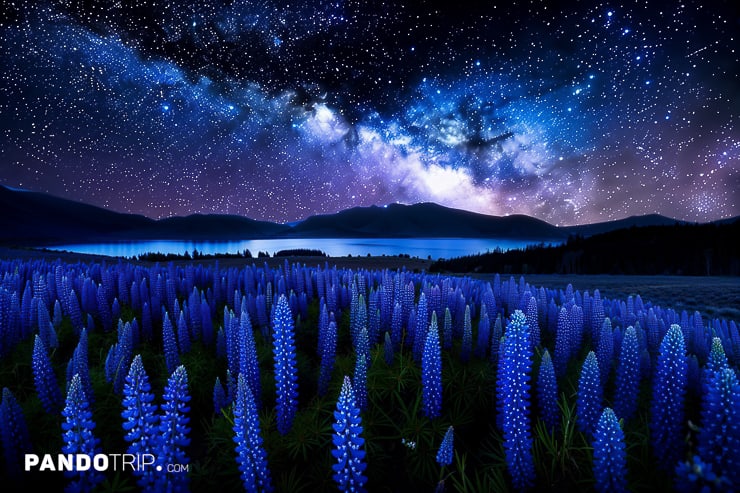
You haven’t really seen the stars until you’ve seen them from Lake Tekapo. This glacial lake in inland Canterbury provides some of the most spectacular star gazing in New Zealand, thanks to its high-altitude location and clear, pollution-free skies.
What makes Lake Tekapo exceptional for stargazing is its status as an International Dark Sky Reserve. This prestigious designation from the International Dark-Sky Association recognizes the finest star-gazing destinations based on exceptional night sky quality, natural darkness, and efforts preserving that darkness. As the first Dark Sky Reserve outside North America, Lake Tekapo offers unusually brilliant displays of southern hemisphere constellations like the Southern Cross, along with unobstructed views of the Milky Way stretching gloriously across the night sky.
Lake Tekapo also hosts unique natural phenomena like the Southern Lights (Aurora Australis) lighting up the heavens with shimmering curtains of green, pink and purple. This celestial light show rivals the Northern Lights in brilliance, but with its own distinctive southern flair.
A variety of stargazing tours allow visitors to fully experience Tekapo’s magical nighttime display. But you don’t need a telescope to enjoy the dazzling show. Simply head down to the lakefront, stretch out on the grass and let your eyes adjust until the full glory of space reveals itself overhead in stunning clarity.
While the lake shines brightest under cover of darkness, Tekapo still impresses by daylight. Its distinctive turquoise-blue colored water, framed by the rugged peaks of the Southern Alps and the rolling Mackenzie Basin landscape, makes for an incredibly scenic backdrop for photography. During springtime the area surrounding Lake Tekapo erupts in color as lupine flowers blanket the ground, creating a vibrant natural mosaic that contrasts exquisitely with the bright blue lake waters.
While famous Canadian lakes such as Lake Louise and Moraine Lake offer similarly-hued waters backed by impressive mountain scenery, they can’t compete with Tekapo’s acclaimed Dark Sky Reserve or colorful floral display in springtime. Within New Zealand, the equally gorgeous Lake Pukaki provides stiff competition, but Tekapo still stands out for its accessibility and wealth of viewing platforms showcasing its charms from every perfect angle.




For travelers wishing to experience New Zealand’s majestic alpine scenery alongside world-class stargazing, Lake Tekapo is certainly an unmissable highlight. Its waters inspire awe by daylight just as its dark skies have earned Tekapo worthy recognition as one of the world’s premier destinations for connecting with the infinite wonders of space at night.
6. Conquer the Clouds: Mount Cook/Aoraki

Towering at 3,724 meters (12,218 feet), Mount Cook, also known by its Māori name Aoraki, is New Zealand’s highest mountain. While it doesn’t compare to the world’s tallest peaks in the Himalayas like Everest or K2, Mount Cook is considered one of the most challenging mountains to climb on Earth—comparable to famous peaks in Peru, Alaska, and Nepal.
Its difficulty comes from factors like its isolation from other tall mountains, exposure to unpredictable high-altitude weather, and a complex mix of rock, snow and ice climbing. The lethal conditions mean most guides won’t take inexperienced climbers up Mount Cook. Even the legendary Sir Edmund Hillary, the first person to reach the summit of Everest, used Mount Cook to train for the Himalayas.
Thankfully, conquering the summit is not the only way to experience Mount Cook. Hiking trails like Hooker Valley Track offer glimpses of the mountain’s scale from safer terrain. The 10 km round trip winds through alpine vegetation and crosses swing bridges over glacial rivers, leading to a viewpoint of Mount Cook’s sheer precipices and the terminus lake of Hooker Glacier. The well-graded trail makes this peaceful valley accessible for most fitness levels.
Scenic flights also provide a unique aerial showcase without the summit’s dangers. These trips depart from Mt Cook Airport and showcase the region’s jagged alpine peaks from an aerial perspective. Flights circle Tasman Glacier, New Zealand’s longest at 29 km, before approaching Mount Cook and its surrounding summits. No matter the vantage point, Aoraki gifts visitors with a vision of raw alpine wilderness found nowhere else on the islands.
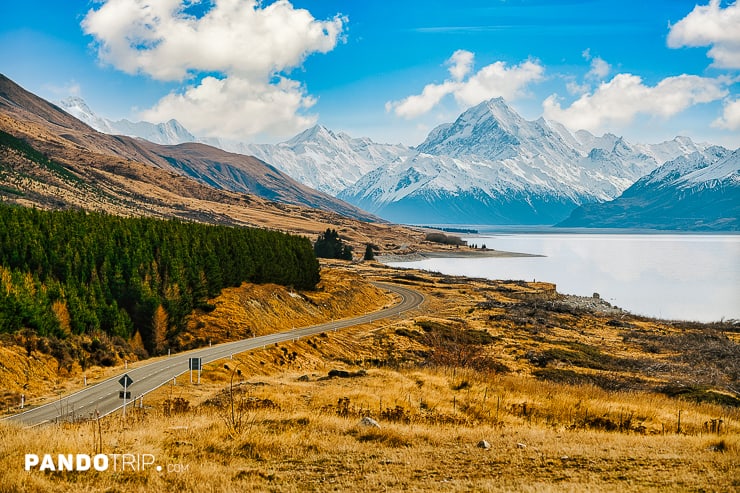



In many ways, Mount Cook embodies the thrill and grandeur that draws outdoor adventurers to New Zealand from across the globe. While only master climbers can hope to stand on its summit, travelers of all abilities can still bear witness to its imposing magnificence. As the Māori proverb says: “If you must bow your head, then let it be to the lofty mountain, Aoraki”. This legendary landmark will continue dominating the landscape, casting its immortal shadow over the land.
7. Walk on Ice: Glacier Hiking at Franz Josef Glacier
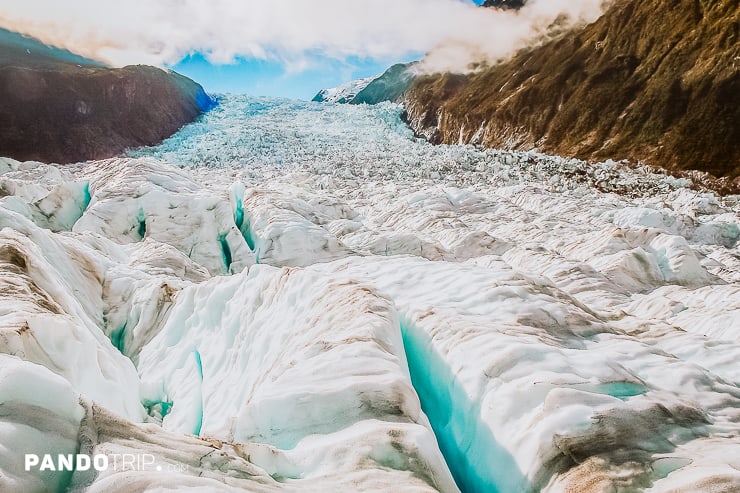
Franz Josef Glacier is one of New Zealand’s most stunning natural attractions. This 12 km long glacier, located on the West Coast of the South Island, is unique in that it extends nearly all the way down to temperate rainforest rather than being perched high up in alpine terrain. This accessibility makes Franz Josef one of the rare chances to view dynamic glaciers up close.
With speeds of up to five meters per day, Franz Josef is one of the fastest moving glaciers in the world. As a result, the glacier remains in a constant state of motion, channeled between the soaring rock walls of the Southern Alps. The ever-changing ice formations sculpt spectacular caves, arches, tunnels and crevasses along its leading edge.
The glacier has rightly earned fame as a mecca for glacier hiking and adventure across its breathtaking terrain. Its signature activity—glacier hiking—leads adventurous groups across the cracked, creaking icy surface that reshapes itself overnight. Local guiding companies offer glacier hikes ranging from short 2-hour adventures to full-day expeditions covering longer distances and greater challenges. For the daring, heli-hiking combines walking across the icy landscapes with helicopter rides for aerial views.
Compared to other famous glaciers like those in Patagonia, Franz Josef offers equally dramatic landscapes and ice trekking experiences. However, what sets Franz Josef apart is its lush rainforest setting, which provides a contrast not found in the drier, colder Patagonian environment. In fact, it is one of only three glaciers in the world that descend into a temperate rainforest, the others being Fox Glacier (also in New Zealand) and Argentina’s Perito Moreno Glacier.


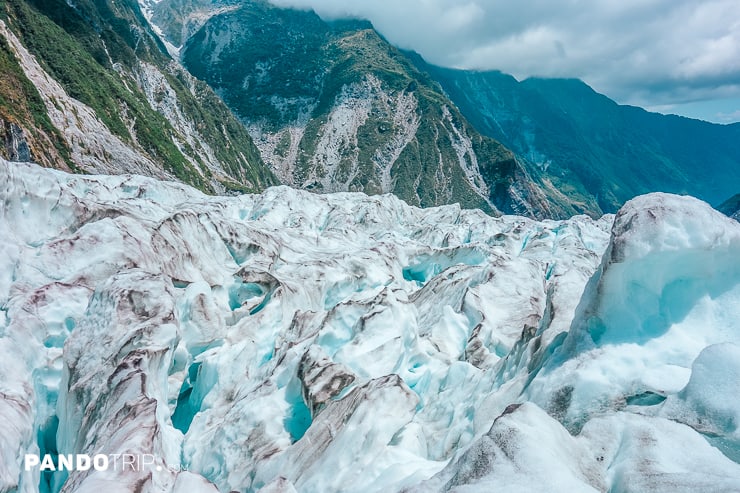

In summary, the combination of Franz Josef’s fast movement, accessibility, and surrounding temperate rainforest is rare among glaciers globally. This distinctive blend of features creates a unique experience that can only be found in New Zealand’s spectacular landscape.
8. Photograph and Hike Up New Zealand’s Mt. Fuji: Taranaki National Park

Rising up from the landscape, Mount Taranaki’s perfectly symmetrical volcanic cone shape has earned it fame as one of the most beautifully formed mountains on earth. Although dormant since its last eruption in 1775, this 120,000 year old mountain towers 2,518 meters into the sky and dominates the lush green countryside surrounding its base.
If you look at Mount Taranaki and think you’ve seen it somewhere, you’re right. It bears a striking resemblance to Mount Fuji, a true symbol of Japan. Taranaki’s symmetrical sloping sides and conical peak so resemble Fuji-san that it stood in for Mount Fuji in the Hollywood film “The Last Samurai” starring Tom Cruise. For those seeking a taste of Japan without leaving New Zealand, Mount Taranaki is a gateway to Japan…iwi style.
Beyond its cinematic connections, Taranaki holds deeper meaning for the Māori tribes that have called this area home for centuries. In 2017, Mount Taranaki was granted legal personhood status in recognition of its spiritual significance to local iwi. This means any harm to the mountain carries consequences just as serious as harm to the tribe itself.
For visitors seeking adventure, a hike up Mount Taranaki offers spectacular 360-degree views from its summit. While often described as New Zealand’s most climbed mountain, summit attempts do require proper precautions and equipment to handle the challenging icy conditions near the glacial peak. For those lacking the skill or stamina for a full summit climb, over 300 km of easier walking tracks cater to all ability levels within Taranaki National Park below. The travel guide Lonely Planet even named Mt Taranaki as the best hike in New Zealand and Australia.
The mountain also draws photography enthusiasts seeking to capture the perfect shot. To take that iconic photo of Taranaki’s peak reflecting perfectly in a pristine alpine lake, head to the Pouakai tarns. These small glacial lakes flawlessly mirror the smooth conical peak looming behind.
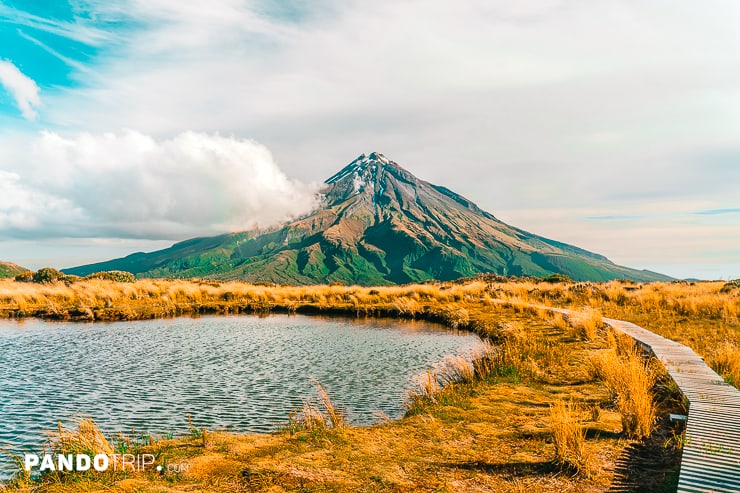


As iconic as it may be, Mount Taranaki stands in a league of its own with its distinctive shape and photogenic features capturing imaginations across the globe. Yet beyond its superficial beauty, it holds much deeper cultural meaning for the native people and vivid green land around it. Those who take the time to venture into Taranaki National Park might just find themselves returning home with their spirits rejuvenated as much as their camera reels full.
9. Discover Middle Earth’s Shire: Hobbiton

Step into Middle-earth at Hobbiton Movie Set, the real-world location used to depict the Shire in Peter Jackson’s Lord of the Rings and Hobbit trilogies. Nestled amongst the rolling hills of the Alexander farm in Matamata, Waikato, Hobbiton brings J.R.R. Tolkien’s vision of the home of the Hobbits to life in vivid detail.
Unlike typical movie sets, which are struck after filming concludes, Hobbiton was reconstructed for permanence after Jackson’s initial Lord of the Rings trilogy, using materials that will last for decades. The attention to detail is remarkable. The forty-four Hobbit holes, the Green Dragon Inn, the Mill and the Party Tree are all recreated straight from the pages of Tolkien’s novels. The holes are not just façades but have complete interiors, and the gardens overflow with vibrant flowers and vegetables just as one would imagine the industrious Hobbits growing. Every single element on the twelve-acre site, from the rustic fences to the scattered farming implements, are intentionally placed to reinforce the illusion that you are transported into the fantastical, pastoral world of Middle-earth.
Much like the films brought this fantasy world to life, visiting Hobbiton in person makes Tolkien’s words materialize with vivid detail. Guided tours take you through the heart of the shire as guides share behind-the-scenes glimpses at how the movie magic was made. The pinnacle of the visit is a stop at the Green Dragon Inn for a pint in the pub frequented by hobbits and wizards.
While Hobbit-themed tourist attractions have sprouted up around the world, none capture the true spirit and charm of this New Zealand original. Underground hygge hobbit holes or luxurious versions on Airbnb offer accommodation, but lack the surrounding scenery and meticulous detail that makes Hobbiton feel like you are immersed in the shire itself. The hilly Lake District in England may boast landscapes reminiscent of Middle Earth locations, but only New Zealand can provide the full experience of bringing Tolkien’s fantasy world to life.




For any Lord of the Rings fan visiting New Zealand, an afternoon spent wandering this impressively detailed hobbit village should top your Middle Earth bucket list. There is simply nowhere else in the world you can discover such a complete recreation of Tolkien’s shire crafted with such accuracy and dedicated artistry. It is a one-of-a-kind opportunity to bring your love of the classic stories vividly to life.
10. Dig Your Own Natural Spa: Hot Water Beach, Coromandel

The Coromandel Peninsula on New Zealand’s North Island is known for its rugged natural beauty, with pristine beaches, lush native forests, and a relaxed pace of life. One of its most unique attractions is Hot Water Beach, where visitors can dig their own makeshift hot tubs in the sand. This is possible thanks to underground thermal springs which heat the water and cause it to bubble up through the sand, creating a DIY natural spa with views of the ocean.
The magic here happens two hours before and after low tide, when the tidal zone exposes the warmest sands. Armed with a shovel (available to rent nearby), find a spot, start digging, and before long you’ll have your very own DIY hot tub to relax in as the ocean laps at your feet. The water temperatures can reach up to 64°C, creating an almost surreal hot tub experience on a beach.
Hot Water Beach is not the only site with hot springs in Coromandel. Similar ‘dig-your-own’ spots can be found at Kawhia Hot Water Beach on the Waikato west coast, though water temperature are generally cooler. For a luxury alternative, The Lost Spring offers geothermal pools amid forest gardens in Whitianga.
Beyond the hot springs, the Coromandel Peninsula is also famed for sights like Cathedral Cove. Named after its iconic rock archway and cliff-flanked beach, Cathedral Cove is a must-see destination in the region and complements Hot Water Beach as a highlight of the peninsula’s natural offerings
While hot springs exist in many countries like Japan and Iceland, none allow you to freely dig your own on-demand spa while overlooking the ocean. It’s an only-in-New Zealand experience that gives new meaning to the term ‘hot tubbing’.

